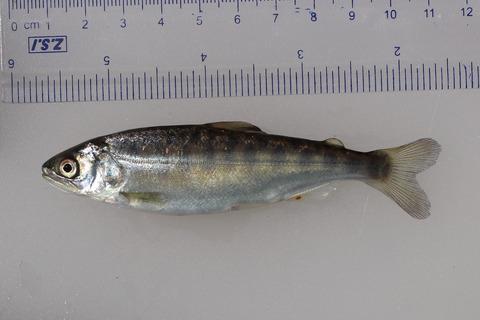当前位置:
X-MOL 学术
›
J. Anim. Ecol.
›
论文详情
Our official English website, www.x-mol.net, welcomes your
feedback! (Note: you will need to create a separate account there.)
An escape theory model for directionally moving prey and an experimental test in juvenile Chinook salmon
Journal of Animal Ecology ( IF 3.5 ) Pub Date : 2020-04-28 , DOI: 10.1111/1365-2656.13233 Megan C Sabal 1 , Joseph E Merz 1, 2 , Suzanne H Alonzo 1 , Eric P Palkovacs 1
Journal of Animal Ecology ( IF 3.5 ) Pub Date : 2020-04-28 , DOI: 10.1111/1365-2656.13233 Megan C Sabal 1 , Joseph E Merz 1, 2 , Suzanne H Alonzo 1 , Eric P Palkovacs 1
Affiliation

|
Abstract Prey evaluate risk and make decisions based on the balance between the costs of predation and those of engaging in antipredator behaviour. Economic escape theory has been valuable in understanding the responses of stationary prey under predation risk; however, current models are not applicable for directionally moving prey. Here we present an extension of existing escape theory that predicts how much predation risk is perceived by directionally moving prey. Perceived risk is measured by the extent antipredator behaviour causes a change in travel speed (the distance to a destination divided by the total time to reach that destination). Cryptic or cautious antipredator behaviour slows travel speed, while prey may also speed up to reduce predator–prey overlap. Next, we applied the sensitization hypothesis to our model, which predicts that prey with more predator experience should engage in more antipredator behaviour, which leads to a larger change in travel speed under predation risk. We then compared the qualitative predictions of our model to the results of a behavioural assay with juvenile Chinook salmon Oncorhynchus tshawytscha that varied in their past predator experience. We timed salmon swimming downstream through a mesh enclosure in the river with and without predator cues present to measure their reaction to a predator. Hatchery salmon had the least predator experience, followed by wild salmon captured upstream (wild‐upstream) and wild‐salmon captured downstream (wild‐downstream). Both wild salmon groups slowed down in response to predator cues, whereas hatchery salmon did not change travel speed. The magnitude of reaction to predator cues by salmon group followed the gradient of previous predator experience, supporting the sensitization hypothesis. Moving animals are conspicuous and vulnerable to predators. Here we provide a novel conceptual framework for understanding how directionally moving prey perceive risk and make antipredator decisions. Our study extends the scope of economic escape theory and improves general understanding of non‐lethal effects of predators on moving prey.
中文翻译:

定向移动猎物的逃逸理论模型及奇努克鲑幼鱼的实验测试
摘要 Prey 评估风险并根据捕食成本与参与反捕食者行为的成本之间的平衡做出决策。经济逃逸理论对于理解静止猎物在捕食风险下的反应很有价值;然而,当前的模型不适用于定向移动的猎物。在这里,我们提出了现有逃逸理论的扩展,该理论预测定向移动的猎物会感知到多少捕食风险。感知风险通过反捕食者行为导致旅行速度变化的程度(到目的地的距离除以到达该目的地的总时间)来衡量。神秘或谨慎的反捕食者行为会减慢行进速度,而猎物也可能会加速以减少捕食者与猎物的重叠。接下来,我们将敏化假设应用于我们的模型,它预测具有更多捕食经验的猎物应该参与更多的反捕食行为,这会导致在捕食风险下的行进速度发生更大的变化。然后,我们将我们模型的定性预测与幼年奇努克鲑鱼 Oncorhynchus tshawytscha 的行为分析结果进行了比较,这些结果在过去的捕食者经历中有所不同。我们对鲑鱼向下游游过河中的网状围栏进行计时,无论是否存在捕食者线索,以测量它们对捕食者的反应。孵化场三文鱼的捕食经历最少,其次是上游捕获的野生三文鱼(wild-upstream)和下游捕获的野生三文鱼(wild-downstream)。两个野生鲑鱼群都因捕食者的线索而减速,而孵化场鲑鱼没有改变行进速度。鲑鱼群对捕食者线索的反应程度遵循先前捕食者经验的梯度,支持致敏假说。移动的动物很显眼,容易受到捕食者的攻击。在这里,我们提供了一个新颖的概念框架,用于理解定向移动的猎物如何感知风险并做出反捕食者的决定。我们的研究扩展了经济逃逸理论的范围,并提高了对捕食者对移动猎物的非致命影响的一般理解。
更新日期:2020-04-28
中文翻译:

定向移动猎物的逃逸理论模型及奇努克鲑幼鱼的实验测试
摘要 Prey 评估风险并根据捕食成本与参与反捕食者行为的成本之间的平衡做出决策。经济逃逸理论对于理解静止猎物在捕食风险下的反应很有价值;然而,当前的模型不适用于定向移动的猎物。在这里,我们提出了现有逃逸理论的扩展,该理论预测定向移动的猎物会感知到多少捕食风险。感知风险通过反捕食者行为导致旅行速度变化的程度(到目的地的距离除以到达该目的地的总时间)来衡量。神秘或谨慎的反捕食者行为会减慢行进速度,而猎物也可能会加速以减少捕食者与猎物的重叠。接下来,我们将敏化假设应用于我们的模型,它预测具有更多捕食经验的猎物应该参与更多的反捕食行为,这会导致在捕食风险下的行进速度发生更大的变化。然后,我们将我们模型的定性预测与幼年奇努克鲑鱼 Oncorhynchus tshawytscha 的行为分析结果进行了比较,这些结果在过去的捕食者经历中有所不同。我们对鲑鱼向下游游过河中的网状围栏进行计时,无论是否存在捕食者线索,以测量它们对捕食者的反应。孵化场三文鱼的捕食经历最少,其次是上游捕获的野生三文鱼(wild-upstream)和下游捕获的野生三文鱼(wild-downstream)。两个野生鲑鱼群都因捕食者的线索而减速,而孵化场鲑鱼没有改变行进速度。鲑鱼群对捕食者线索的反应程度遵循先前捕食者经验的梯度,支持致敏假说。移动的动物很显眼,容易受到捕食者的攻击。在这里,我们提供了一个新颖的概念框架,用于理解定向移动的猎物如何感知风险并做出反捕食者的决定。我们的研究扩展了经济逃逸理论的范围,并提高了对捕食者对移动猎物的非致命影响的一般理解。











































 京公网安备 11010802027423号
京公网安备 11010802027423号